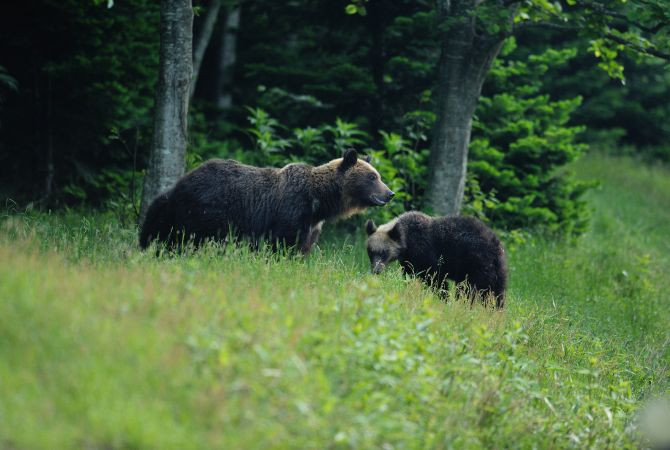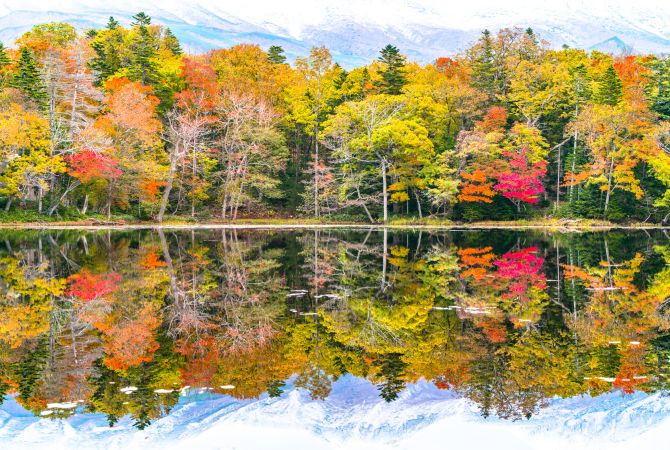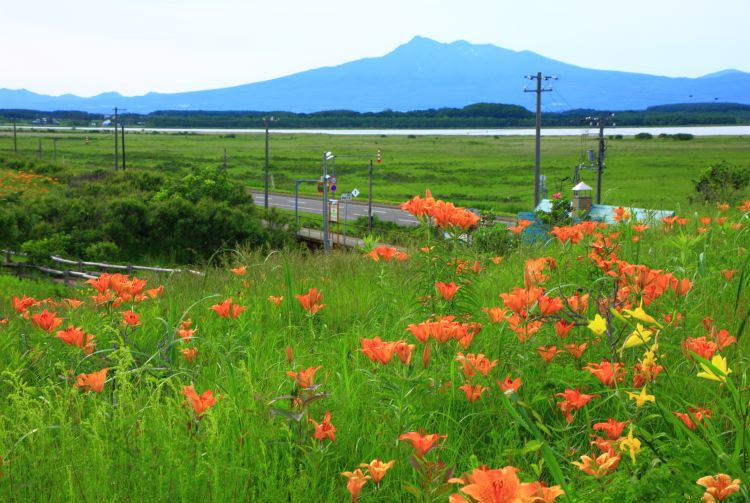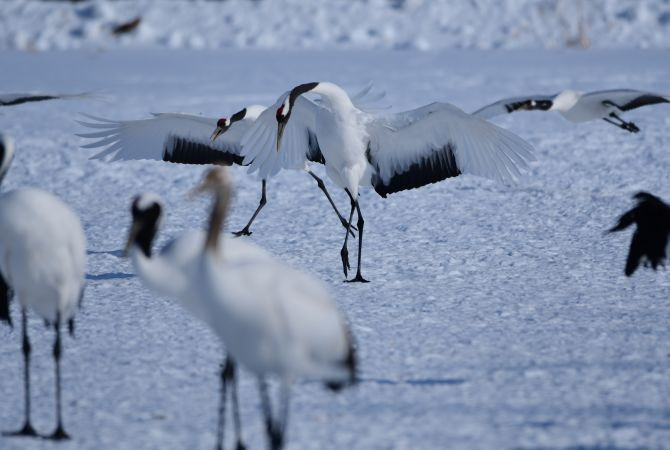Kushiro Tourism offers unique experiences from stunning natural landscapes to diverse wildlife encounters. Let SIXT.VN guide you through planning an unforgettable adventure with our expert advice, reliable transportation, and curated services, ensuring a seamless and enriching travel experience. Consider booking airport transfers, convenient accommodations, and guided tours.
1. What Makes Kushiro a Unique Tourism Destination?
Kushiro is unique due to its unspoiled natural landscapes and diverse wildlife habitats. This remote corner of Japan is home to Japan’s largest marshland, the Kushiro Marsh, as well as stunning national parks.
Kushiro offers a unique blend of natural beauty and wildlife experiences that set it apart from other tourist destinations. The region’s main attraction, the Kushiro Marsh (Kushiro Shitsugen), is Japan’s largest marshland, offering visitors a chance to witness rare flora and fauna. According to a report by the Ministry of the Environment of Japan in 2023, the marshland supports over 700 species of plants and numerous endangered animal species, making it a haven for nature enthusiasts and researchers alike. This unique ecosystem provides a habitat for iconic species like the Japanese red-crowned crane (Grus japonensis), also known as the “Tancho,” which is a symbol of longevity and good fortune in Japanese culture.
Beyond the marsh, Kushiro boasts picturesque landscapes, including pristine lakes, forests, and coastlines. Lake Akan, famous for its marimo algae balls, and Lake Mashu, known for its crystal-clear waters, add to the region’s scenic appeal. Furthermore, Kushiro’s coastal areas offer opportunities for whale and bird watching, making it a year-round destination for nature lovers. The region’s commitment to preserving its natural heritage ensures that visitors can experience a pristine and authentic side of Japan that is increasingly rare in today’s world.
Here is a table summarizing Kushiro’s unique tourism offerings:
| Feature | Description |
|---|---|
| Kushiro Marsh | Japan’s largest marshland, home to diverse flora and fauna. |
| Red-crowned Crane | Symbol of longevity, found in Kushiro Marsh. |
| Lake Akan | Famous for marimo algae balls. |
| Lake Mashu | Known for crystal-clear waters. |
| Coastal Areas | Whale and bird watching opportunities. |
2. What Are The Top Tourist Attractions to Visit in Kushiro?
Top attractions in Kushiro include the Kushiro Marsh, Lake Akan, Lake Mashu, and the Kushiro City Museum. These sites offer a diverse range of natural and cultural experiences.
Kushiro offers a diverse array of attractions, blending natural wonders with cultural insights. The Kushiro Marsh, the largest marshland in Japan, is a must-visit for nature enthusiasts. It is home to the Japanese red-crowned crane and offers scenic walking trails and observation points. According to the Kushiro City Tourism Association, the best time to visit the marsh is during the early morning or late afternoon, when wildlife is most active.
Lake Akan is another highlight, famous for its unique marimo algae balls. Visitors can take a boat tour on the lake, visit the Marimo Exhibition and Observation Center, and explore the nearby Akan Kohan Eco-Museum Center to learn more about the local ecosystem. The Ainu Kotan, a traditional Ainu village, offers a glimpse into the indigenous culture of Hokkaido, with traditional dances, crafts, and cuisine.
Lake Mashu is renowned for its crystal-clear waters and breathtaking scenery, often shrouded in mist, adding to its mystique. The Teshikaga Town Tourism Association recommends visiting the lake on a clear day for the best views. Additionally, the Kushiro City Museum provides insights into the region’s history, culture, and natural environment, making it a valuable stop for those interested in learning about Kushiro’s heritage.
Here is a table summarizing the top tourist attractions in Kushiro:
| Attraction | Description |
|---|---|
| Kushiro Marsh | Largest marshland in Japan, home to red-crowned cranes. |
| Lake Akan | Famous for marimo algae balls and Ainu culture. |
| Lake Mashu | Known for its crystal-clear waters and scenic beauty. |
| Ainu Kotan | Traditional Ainu village showcasing indigenous culture. |
| Kushiro City Museum | Insights into the region’s history, culture, and natural environment. |
 Kushiro Marshland offering scenic views
Kushiro Marshland offering scenic views
3. When is the Best Time to Visit Kushiro for Optimal Tourism Experiences?
The best time to visit Kushiro is during the spring (May-June) and autumn (September-October) for pleasant weather and vibrant scenery. Winter (December-February) offers unique ice-related attractions.
The optimal time to visit Kushiro depends largely on your interests and what you want to experience. Spring (May-June) and autumn (September-October) generally offer the most pleasant weather, with mild temperatures and fewer crowds compared to the peak summer months. Spring brings the blooming of wildflowers and lush greenery, while autumn showcases the vibrant foliage of the region’s forests.
According to the Japan Meteorological Agency, these shoulder seasons also have a lower chance of rainfall, making outdoor activities more enjoyable. However, winter (December-February) offers a unique appeal, particularly for those interested in ice-related attractions. The coastal areas of Kushiro see the arrival of drift ice, creating stunning winter landscapes. Additionally, it’s the best time for observing the red-crowned cranes, as they gather in larger numbers during the winter months. Keep in mind that winter temperatures can drop significantly, so dressing warmly is essential.
Here is a table summarizing the best times to visit Kushiro for different interests:
| Season | Months | Advantages | Considerations |
|---|---|---|---|
| Spring | May-June | Pleasant weather, blooming wildflowers, fewer crowds. | Occasional rain showers. |
| Summer | July-August | Warm weather, ideal for outdoor activities. | Peak tourist season, higher prices, more crowds. |
| Autumn | September-October | Mild temperatures, vibrant foliage, fewer crowds. | Chance of typhoons. |
| Winter | December-February | Drift ice, red-crowned crane observation, unique winter landscapes. | Cold temperatures, heavy snowfall in some areas. |
4. How Can I Get Around Kushiro Efficiently and Affordably?
Efficient and affordable transportation in Kushiro includes rental cars, local buses, and trains. Rental cars offer flexibility, while buses and trains provide cost-effective options.
Navigating Kushiro efficiently and affordably requires considering various transportation options to suit your needs and budget. Renting a car is a popular choice for many visitors, providing the flexibility to explore remote areas and scenic routes at your own pace. Several car rental agencies operate at Kushiro Airport and within the city, offering a range of vehicles to choose from. However, keep in mind that driving in Japan requires an international driving permit.
Local buses are a cost-effective way to get around Kushiro, with regular services connecting major attractions and towns. The Kushiro City Bus operates numerous routes within the city, while intercity buses provide access to destinations further afield. Japan Rail (JR) trains are another convenient option, particularly for traveling between cities and regions. The JR Hokkaido network connects Kushiro to other major cities in Hokkaido, such as Sapporo and Hakodate.
Here is a table summarizing the transportation options in Kushiro:
| Transportation | Advantages | Disadvantages |
|---|---|---|
| Rental Car | Flexibility to explore remote areas, convenient for families and groups. | Requires an international driving permit, can be expensive (rental fees, gas, parking), potential for traffic. |
| Local Buses | Cost-effective, regular services to major attractions. | Can be time-consuming, limited routes in remote areas, language barrier. |
| JR Trains | Convenient for traveling between cities, comfortable and efficient. | Limited routes within Kushiro city, can be expensive for frequent use. |
| Taxis | Readily available in urban areas, convenient for short distances. | More expensive than buses and trains, language barrier with some drivers. |
5. What Types of Accommodation Are Available in Kushiro for Tourists?
Accommodation options in Kushiro range from traditional Ryokans and hotels to budget-friendly guesthouses and hostels. These cater to different preferences and budgets.
Kushiro offers a variety of accommodation options to cater to different travel styles and budgets. Traditional Japanese inns (Ryokans) provide an immersive cultural experience, with tatami-mat flooring, futon beds, and on-site hot springs (Onsen). Many Ryokans also offer traditional Japanese cuisine, allowing guests to savor local flavors. Hotels in Kushiro range from budget-friendly business hotels to more luxurious establishments with modern amenities. These are often located in the city center and offer convenient access to shopping, dining, and transportation.
Guesthouses and hostels are ideal for budget-conscious travelers, providing affordable accommodation in a social atmosphere. These often offer dormitory-style rooms and shared facilities, as well as opportunities to meet other travelers. Additionally, vacation rentals, such as apartments and houses, are available for those seeking more space and privacy. These are particularly suitable for families or groups traveling together.
Here is a table summarizing the accommodation options in Kushiro:
| Accommodation Type | Description | Advantages | Disadvantages |
|---|---|---|---|
| Ryokans | Traditional Japanese inns with tatami mats, futon beds, and onsen. | Immersive cultural experience, on-site hot springs, traditional cuisine. | Can be more expensive, language barrier may be an issue for some travelers. |
| Hotels | Range from budget-friendly to luxurious, with modern amenities. | Convenient locations, range of amenities, suitable for business and leisure travelers. | Can lack the cultural charm of Ryokans, may be more impersonal. |
| Guesthouses/Hostels | Affordable accommodation with dormitory-style rooms and shared facilities. | Budget-friendly, social atmosphere, opportunities to meet other travelers. | Limited privacy, shared facilities, may not be suitable for families. |
| Vacation Rentals | Apartments and houses with more space and privacy. | More space and privacy, suitable for families and groups, often come with kitchen facilities. | Can be located further from city center, may require more planning. |
 Tranquil Lake Akan
Tranquil Lake Akan
6. What Local Cuisine Should I Try During My Visit to Kushiro?
Must-try local cuisine in Kushiro includes Robata-yaki (fireside-grilled seafood), Zangi (Hokkaido-style fried chicken), and Kushiro Ramen, offering a taste of regional flavors.
Kushiro offers a culinary adventure that showcases the region’s fresh seafood and local ingredients. Robata-yaki, or fireside-grilled seafood, is a must-try, with a variety of fish, shellfish, and vegetables grilled over hot coals, imparting a smoky flavor. According to the Kushiro Tourism and Convention Association, some of the best Robata-yaki restaurants can be found near Kushiro’s harbor.
Zangi, Hokkaido-style fried chicken, is another local favorite, known for its crispy exterior and juicy interior. It is often seasoned with ginger, garlic, and soy sauce, giving it a unique flavor. Kushiro Ramen, a regional variation of ramen, typically features a rich soy sauce-based broth and local seafood toppings. Additionally, don’t miss the opportunity to try fresh seafood dishes such as crab, salmon, and sea urchin, which are abundant in the region.
Here is a table summarizing the must-try local cuisine in Kushiro:
| Cuisine | Description | Key Ingredients | Where to Try |
|---|---|---|---|
| Robata-yaki | Fireside-grilled seafood and vegetables. | Fresh seafood (fish, shellfish), local vegetables, charcoal. | Restaurants near Kushiro harbor. |
| Zangi | Hokkaido-style fried chicken. | Chicken, ginger, garlic, soy sauce, flour. | Local restaurants and izakayas (Japanese pubs). |
| Kushiro Ramen | Regional ramen with soy sauce-based broth and seafood toppings. | Ramen noodles, soy sauce broth, local seafood (crab, salmon), vegetables. | Ramen shops throughout Kushiro. |
| Fresh Seafood | Crab, salmon, sea urchin, and other seafood dishes. | Fresh seafood, various preparation methods (sashimi, grilled, steamed). | Seafood markets and restaurants. |
7. What Cultural Experiences Can Tourists Engage in While in Kushiro?
Tourists can engage in cultural experiences such as visiting the Ainu Kotan, attending local festivals, and exploring historical sites to understand Kushiro’s heritage.
Kushiro offers a rich tapestry of cultural experiences that allow visitors to delve into the region’s unique heritage. A visit to the Ainu Kotan, a traditional Ainu village near Lake Akan, is a must for those interested in learning about the indigenous culture of Hokkaido. The village showcases traditional Ainu houses, crafts, and dances, offering a glimpse into the lives of the Ainu people.
Attending local festivals is another great way to immerse yourself in Kushiro’s culture. The Kushiro Ice Festival, held in winter, features impressive ice sculptures and winter activities. The Kushiro Port Festival, held in summer, celebrates the city’s maritime heritage with parades, food stalls, and live music. Exploring historical sites, such as the Kushiro City Museum and the nearby historical landmarks, provides insights into the region’s past.
Here is a table summarizing the cultural experiences in Kushiro:
| Experience | Description | Highlights |
|---|---|---|
| Ainu Kotan | Traditional Ainu village near Lake Akan. | Traditional Ainu houses, crafts, dances, cultural performances. |
| Kushiro Ice Festival | Winter festival with ice sculptures and activities. | Impressive ice sculptures, winter games, food stalls. |
| Kushiro Port Festival | Summer festival celebrating the city’s maritime heritage. | Parades, food stalls, live music, fireworks. |
| Kushiro City Museum | Museum showcasing the region’s history and culture. | Exhibits on local history, Ainu culture, natural environment. |
8. What Outdoor Activities Are Popular Among Tourists in Kushiro?
Popular outdoor activities in Kushiro include hiking in Kushiro Marsh, bird watching, canoeing on Lake Akan, and wildlife viewing in Shiretoko National Park.
Kushiro’s stunning natural landscapes offer a wealth of outdoor activities for visitors to enjoy. Hiking in the Kushiro Marsh is a popular choice, with well-maintained trails providing access to scenic viewpoints and wildlife observation areas. According to the Ministry of the Environment, the marsh is home to over 140 species of birds, making it a paradise for bird watchers. Canoeing on Lake Akan is another great way to experience the region’s natural beauty, with guided tours available for all skill levels.
Wildlife viewing in Shiretoko National Park, a UNESCO World Heritage Site, is a must for nature enthusiasts. The park is home to a variety of wildlife, including brown bears, deer, and foxes. Additionally, fishing is a popular activity in Kushiro, with opportunities for both freshwater and saltwater fishing.
Here is a table summarizing the outdoor activities in Kushiro:
| Activity | Description | Highlights |
|---|---|---|
| Hiking in Kushiro Marsh | Exploring the marshland on foot. | Scenic viewpoints, wildlife observation, bird watching. |
| Bird Watching | Observing various bird species in Kushiro. | Red-crowned cranes, migratory birds, diverse avian species. |
| Canoeing on Lake Akan | Paddling on the lake. | Scenic views, exploring the lake’s islands, enjoying the peaceful atmosphere. |
| Wildlife Viewing in Shiretoko National Park | Observing wildlife in their natural habitat. | Brown bears, deer, foxes, diverse wildlife species. |
| Fishing | Catching fish in freshwater and saltwater locations. | Salmon, trout, various fish species. |
 Swan resting on frozen Lake
Swan resting on frozen Lake
9. How Can Tourists Respect Local Customs and Etiquette in Kushiro?
Respect local customs in Kushiro by learning basic Japanese phrases, removing shoes when entering homes or Ryokans, and being mindful of noise levels in public spaces.
Respecting local customs and etiquette is essential for a positive and enriching travel experience in Kushiro. Learning a few basic Japanese phrases, such as “Konnichiwa” (hello) and “Arigato” (thank you), can go a long way in showing respect and appreciation. When entering homes, Ryokans, or some traditional restaurants, it is customary to remove your shoes. Slippers are often provided for indoor use.
Being mindful of noise levels in public spaces, such as trains and buses, is also important. Avoid talking loudly on your phone and refrain from playing music without headphones. Tipping is not customary in Japan, and attempting to tip may cause confusion or even offense. Instead, express your gratitude with a sincere “Arigato.”
Here is a table summarizing the local customs and etiquette in Kushiro:
| Custom/Etiquette | Description | Tips |
|---|---|---|
| Basic Japanese Phrases | Learning a few basic phrases in Japanese. | “Konnichiwa” (hello), “Arigato” (thank you), “Sumimasen” (excuse me). |
| Removing Shoes | Taking off shoes when entering homes, Ryokans, or some traditional restaurants. | Look for the designated shoe removal area and use the slippers provided. |
| Noise Levels | Being mindful of noise levels in public spaces. | Avoid loud conversations on phones, refrain from playing music without headphones. |
| Tipping | Tipping is not customary in Japan. | Instead of tipping, express your gratitude with a sincere “Arigato.” |
10. What Are Some Day Trip Destinations From Kushiro That Tourists Should Consider?
Consider day trips from Kushiro to Lake Mashu, Shiretoko National Park, and Akan National Park to explore nearby scenic and natural attractions.
Several day trip destinations from Kushiro offer opportunities to explore the surrounding region’s natural beauty and cultural attractions. Lake Mashu, known for its crystal-clear waters and breathtaking scenery, is a popular choice. The lake is located about a 2-hour drive from Kushiro and offers several viewpoints for admiring its beauty. Shiretoko National Park, a UNESCO World Heritage Site, is another must-visit destination.
Located about a 3-hour drive from Kushiro, the park is home to a variety of wildlife and offers hiking trails, scenic drives, and boat tours. Akan National Park, known for its volcanic landscapes, hot springs, and Lake Akan, is also worth a visit. The park is located about a 1.5-hour drive from Kushiro and offers opportunities for hiking, canoeing, and exploring the Ainu culture.
Here is a table summarizing the day trip destinations from Kushiro:
| Destination | Description | Highlights | Distance from Kushiro |
|---|---|---|---|
| Lake Mashu | Known for its crystal-clear waters and scenic beauty. | Viewpoints, hiking trails, pristine lake environment. | 2 hours drive |
| Shiretoko National Park | UNESCO World Heritage Site with diverse wildlife and natural landscapes. | Hiking trails, scenic drives, boat tours, wildlife viewing. | 3 hours drive |
| Akan National Park | Known for its volcanic landscapes, hot springs, and Lake Akan. | Hiking, canoeing, hot springs, Ainu culture. | 1.5 hours drive |
 Lush scenery surrounding Hokkaido
Lush scenery surrounding Hokkaido
11. What Are Some Lesser-Known Hidden Gems in Kushiro?
Discover hidden gems in Kushiro such as the Onnenai Visitor Center, the Hosooka Observatory, and the Lake Onneto, offering unique and serene experiences away from the crowds.
Beyond the popular tourist spots, Kushiro has several lesser-known hidden gems that offer unique and serene experiences. The Onnenai Visitor Center, located in the Kushiro Marsh, provides in-depth information about the marsh’s ecosystem and offers guided tours. According to the Kushiro City Tourism Association, the center is a great starting point for exploring the marsh.
The Hosooka Observatory offers panoramic views of the Kushiro Marsh and the surrounding landscape, providing a less crowded alternative to the more popular observation points. Lake Onneto, located in Akan National Park, is a hidden gem known for its stunning natural beauty and tranquil atmosphere.
Here is a table summarizing the hidden gems in Kushiro:
| Attraction | Description | Highlights |
|---|---|---|
| Onnenai Visitor Center | Information center about the Kushiro Marsh ecosystem. | Exhibits, guided tours, marshland information. |
| Hosooka Observatory | Panoramic views of the Kushiro Marsh. | Less crowded, scenic views, marshland landscape. |
| Lake Onneto | Stunning natural beauty and tranquil atmosphere in Akan National Park. | Pristine lake, peaceful atmosphere, scenic views. |
12. How Can I Plan a Budget-Friendly Trip to Kushiro?
Plan a budget-friendly trip by opting for guesthouses, using public transport, eating at local eateries, and taking advantage of free attractions like parks and temples.
Traveling to Kushiro on a budget is entirely possible with some careful planning and resourcefulness. Opting for budget-friendly accommodation, such as guesthouses and hostels, can significantly reduce your expenses. These often offer dormitory-style rooms and shared facilities at affordable rates.
Utilizing public transportation, such as local buses and JR trains, is another way to save money on transportation. Purchasing a Japan Rail Pass can be a cost-effective option if you plan on traveling extensively by train. Eating at local eateries, such as ramen shops and izakayas (Japanese pubs), can be much cheaper than dining at tourist-oriented restaurants.
Taking advantage of free attractions, such as parks, temples, and scenic viewpoints, is a great way to experience Kushiro without spending a lot of money.
Here is a table summarizing how to plan a budget-friendly trip to Kushiro:
| Strategy | Description | Tips |
|---|---|---|
| Budget Accommodation | Opt for guesthouses, hostels, or budget hotels. | Book in advance, look for deals, consider staying outside the city center. |
| Public Transportation | Utilize local buses and JR trains. | Purchase a Japan Rail Pass if traveling extensively by train, use local buses for city travel. |
| Local Eateries | Dine at ramen shops, izakayas, and local restaurants. | Look for set menus, try local specialties, avoid tourist-oriented restaurants. |
| Free Attractions | Visit parks, temples, and scenic viewpoints that are free to enter. | Explore Kushiro Marsh, visit Lake Akan, hike in Akan National Park. |
13. What Travel Tips Are Essential For First-Time Visitors to Kushiro?
Essential travel tips for first-timers include obtaining a Japan Rail Pass, carrying cash, learning basic Japanese, and being prepared for varied weather conditions.
For first-time visitors to Kushiro, there are several essential travel tips to keep in mind for a smooth and enjoyable experience. Obtaining a Japan Rail Pass is highly recommended if you plan on traveling extensively by train throughout Japan, as it can save you a significant amount of money. Carrying cash is important, as many smaller establishments in Kushiro may not accept credit cards.
Learning a few basic Japanese phrases can be helpful in communicating with locals, especially in areas where English is not widely spoken. Being prepared for varied weather conditions is also essential, as Kushiro’s climate can be unpredictable. Pack layers of clothing to adapt to changing temperatures, and bring rain gear or an umbrella, especially during the rainy season.
Here is a table summarizing essential travel tips for first-time visitors to Kushiro:
| Tip | Description | Importance |
|---|---|---|
| Japan Rail Pass | Consider purchasing a Japan Rail Pass if traveling extensively by train. | Saves money on train travel, convenient for exploring multiple regions. |
| Carry Cash | Have cash on hand for smaller establishments that may not accept credit cards. | Ensures you can make purchases at local shops and restaurants. |
| Basic Japanese | Learn a few basic Japanese phrases. | Facilitates communication with locals, shows respect for the culture. |
| Varied Weather | Be prepared for varied weather conditions. | Pack layers of clothing, bring rain gear or an umbrella. |
 Green forests of Hokkaido
Green forests of Hokkaido
14. How Can SIXT.VN Enhance My Tourism Experience in Kushiro?
SIXT.VN enhances your tourism experience by providing reliable transportation options, hotel booking assistance, and curated tour packages to ensure a seamless and enjoyable trip.
SIXT.VN is dedicated to enhancing your tourism experience in Kushiro by providing a range of services tailored to your needs. Our reliable transportation options, including airport transfers and car rentals, ensure that you can travel around Kushiro comfortably and efficiently. According to customer feedback, our professional and punctual service has been a key factor in creating stress-free travel experiences.
Our hotel booking assistance helps you find the perfect accommodation to suit your preferences and budget, with a wide selection of hotels, Ryokans, and guesthouses to choose from. Additionally, our curated tour packages offer unique and immersive experiences, allowing you to explore Kushiro’s natural and cultural attractions with expert guidance.
Here is a table summarizing how SIXT.VN enhances your tourism experience in Kushiro:
| Service | Description | Benefits |
|---|---|---|
| Transportation Options | Airport transfers and car rentals. | Comfortable and efficient travel, flexibility to explore the region at your own pace. |
| Hotel Booking Assistance | Wide selection of hotels, Ryokans, and guesthouses. | Find the perfect accommodation to suit your preferences and budget. |
| Tour Packages | Curated tour packages with unique and immersive experiences. | Explore Kushiro’s natural and cultural attractions with expert guidance. |
15. What Safety Precautions Should Tourists Be Aware of When Visiting Kushiro?
Tourists should be aware of wildlife safety, weather-related risks, and earthquake preparedness when visiting Kushiro, ensuring a safe and responsible travel experience.
When visiting Kushiro, it is essential to be aware of certain safety precautions to ensure a safe and responsible travel experience. Wildlife safety is a primary concern, particularly in areas such as Shiretoko National Park, where brown bears are present. It is important to follow park guidelines, such as carrying bear bells and avoiding hiking alone, to minimize the risk of encounters.
Weather-related risks, such as sudden changes in temperature and heavy snowfall in winter, should also be taken into consideration. Check the weather forecast before embarking on outdoor activities, and dress appropriately for the conditions. Earthquake preparedness is another important aspect to be aware of, as Japan is prone to earthquakes. Familiarize yourself with earthquake safety procedures, such as seeking shelter under a sturdy table or desk, and stay informed about potential risks.
Here is a table summarizing the safety precautions to be aware of in Kushiro:
| Precaution | Description | Tips |
|---|---|---|
| Wildlife Safety | Being aware of wildlife risks, particularly brown bears in Shiretoko National Park. | Follow park guidelines, carry bear bells, avoid hiking alone. |
| Weather-Related Risks | Being prepared for sudden changes in temperature and heavy snowfall. | Check the weather forecast, dress in layers, bring appropriate gear. |
| Earthquake Preparedness | Familiarizing yourself with earthquake safety procedures. | Seek shelter under a sturdy table or desk, stay informed about potential risks. |
Kushiro offers a captivating blend of natural beauty, cultural richness, and unique experiences that make it a worthwhile destination for any traveler. By keeping the aforementioned Kushiro tourism tips in mind, you can ensure a memorable and rewarding trip. Let SIXT.VN assist you in planning your perfect Kushiro adventure! Address: 260 Cau Giay, Hanoi, Vietnam. Hotline/Whatsapp: +84 986 244 358. Website: SIXT.VN.
FAQs About Kushiro Tourism
-
What is Kushiro most famous for?
Kushiro is most famous for its stunning natural landscapes, including the Kushiro Marsh (Japan’s largest marshland) and the red-crowned cranes that inhabit it.
-
How do I get to Kushiro?
You can reach Kushiro by flying into Kushiro Airport, which has direct flights from major cities like Tokyo and Sapporo, or by taking the JR train to Kushiro Station.
-
What is the best time of year to see the red-crowned cranes in Kushiro?
The best time to see the red-crowned cranes is during the winter months (December to February) when they gather in larger numbers.
-
Are there any English-speaking tour guides available in Kushiro?
Yes, there are English-speaking tour guides available in Kushiro, but it is best to book in advance to ensure availability. SIXT.VN can assist with arranging guided tours.
-
What should I pack for a trip to Kushiro?
Pack layers of clothing, as the weather can be unpredictable. Include waterproof gear, comfortable walking shoes, and insect repellent.
-
Is it easy to travel around Kushiro without speaking Japanese?
While it’s possible, learning basic Japanese phrases will enhance your experience. English signage is limited in some areas, so having a translation app can be helpful.
-
What is the Ainu Kotan, and why should I visit?
The Ainu Kotan is a traditional Ainu village that provides insights into the indigenous culture of Hokkaido. It offers cultural performances, crafts, and traditional cuisine.
-
What are some popular souvenirs to buy in Kushiro?
Popular souvenirs include marimo algae balls from Lake Akan, Ainu crafts, and local food products like seafood and sweets.
-
Are there any onsen (hot springs) in Kushiro?
Yes, there are several onsen in Kushiro, including those in Akan National Park and near Lake Akan, offering relaxing hot spring experiences.
-
How can SIXT.VN help me plan my trip to Kushiro?
SIXT.VN can assist with transportation, hotel bookings, curated tour packages, and travel advice to ensure a seamless and enjoyable trip to Kushiro. Contact us at Address: 260 Cau Giay, Hanoi, Vietnam. Hotline/Whatsapp: +84 986 244 358. Website: SIXT.VN.



